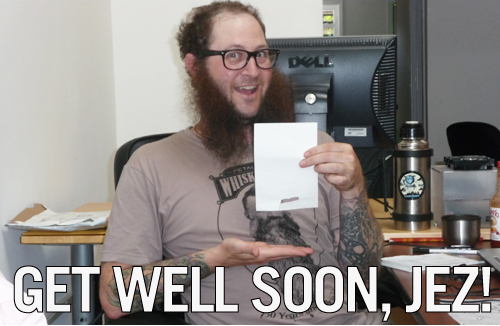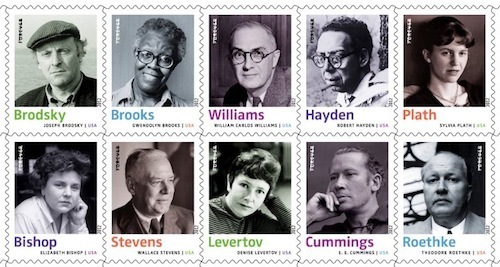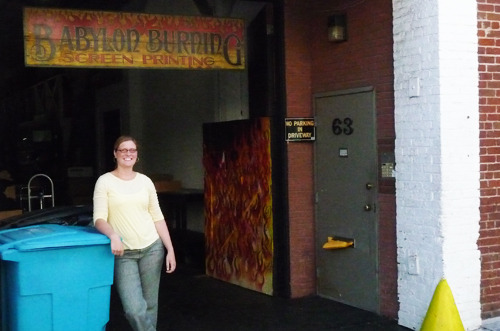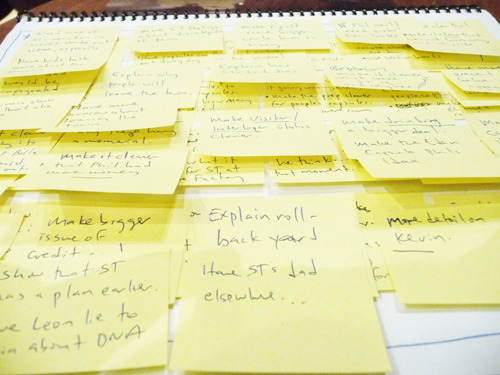Chris Baty's Blog, page 256
September 9, 2011
Heal Our Jez!

So you know Jezra?
Our beloved web programmer who also just happens to be the Petaluma Whiskerino Sideburns Champion? The guy who saves the tin foil from every burrito he eats and uses it to make an ever-growing aluminum sphere that may soon be large enough to have its own gravitational field?
Yep. That Jezra.
Out of nowhere, Jezra came down with severe muscle spasms in his neck last week, and they've generally made it impossible for Jezra to do much more than lie around and be in pain.
We love Jez and want him to get better fast. So if you have the power to heal pinched nerves and muscle spasms through the cyber-ether, can I ask a big favor and have you work your magic now?
You're welcome to lay your hands on the above photo of Jez (who is holding up a piece of paper from which he removed and ate a password to demonstrate effective security measures).
We miss you, Jez.
– Chris B.
September 8, 2011
Let's Get Philatelic

Even though we at OLL remain big fans of writing letters (and of shipping radical new merch, like these YWP "First-Class Novelist" buttons), the U.S. Postal Service is having some tough times lately. Business is down more and more each year, and 3,700 post offices are being considered for closure.
Fortunately, that's not stopping them from cool initiatives, like the 2012 poetry stamp series! Who doesn't want to think about Sylvia Plath's "Daddy" while addressing a Father's Day card, right? Anyway, this new set got me curious about which authors the USPS has honored before.
On this list, all the biggies (Cather, Faulkner, Fitzgerald, Hemingway, Hughes, Steinbeck, Seuss, etc.) are accounted for. Even Ayn Rand is there, but I think rational egoists only send self-addressed stamped envelopes.
Which literature folks do you think deserve a stamp, either now or eventually? (This is not a US-exclusive question, though we're tempted to exclude the UK based on jealousy of their Harry Potter series.) Do you buy special stamps, or are you happy with whatever generic ones your post office has at the ready? Have you ever saved an especially neat stamp from a received letter?
– Chris A.
September 7, 2011
Greetings!

Hey out there in NaNo-Land!
I'm Paige, a temporary import from Canada. I'll be interning with OLL from now until Christmas. It's great to be here!
I'm in my fourth year of university, taking Communications in Professional Writing. This internship will partially fulfill the work-experience component of my degree. I will have a second semester to complete, which I plan to spend freelancing. My dream is to become a famous travel writer or novelist—barring that, cat lady sounds like a good career option. (I have two cats already! On my way!) Or maybe I could just read for a living?
I have a rather serious addiction to used bookstores—I just can't walk past without going in! Anyone out there with the same problem? I've decided to read 100 books in a year, initially to get rid of the large pile of them taking up floor space in my living room. When I'm not writing or reading, I spend a lot of time in my kitchen. I'm a vegan living in a city of meat-lovers, which has pushed me to become rather creative in inventing my favourite ways to cook vegetables. That's another great thing about being here in Berkeley—tons of vegan restaurants!
It's difficult to express just how excited I am about being at OLL (for actual professional and writer-ly reasons, not just the food and sun). This will be my seventh NaNo, and I can't wait to experience the magic from HQ. Plus I get to help out participants from all over the place!
Talk to you soon, everyone.
– Paige
September 6, 2011
REC Everything

I went on vacation with my family recently (Mexico), and shared a camera with my father. This brought back a flood of memories of a syndrome from my childhood. It's called DNVS, and it's as contagious as it is unforgiving.
Depending on when you grew up, you may or may not be familiar with "Dad's New Video (Camera) Syndrome." DNVS is incurable (except by time) and can be exhausting for all involved. Its spread to epidemic levels in the '90s was directly related to the falling prices in video recording technology, and resulted in millions of hours of historically critical footage of babies eating baby food, and your brother taking his first swim in the new avocado-colored kiddie pool.
The infected suffer from an uncontrollable urge to record every moment of passing time on video cassettes. Nothing is so ordinary as to be exempt. The act of capturing "mom doing the dishes" forever seems to lend the activity new value. It is being preserved, framed, erected, and, really, defamiliarized. Watching "mom doing the dishes" later, we may realize many things about the activity we had never considered. "I never realized week-old macaroni could be so… adhesive."
Watching these videos, we may be struck by the sense of desperation in the afflicted's movements. The camera swings wildly from one side of the yard to another, as if terrified that the camera will miss some crucial moment, some critical second of family history. When will Timmy find Johnny, ending this truly epic, table-turning saga of "hide and seek Sunday?"
What is it that's so captivating, seductive, hypnotic about the process of capturing sound and image? DNVS is not limited to video cameras. Still cameras can cause similar bouts of madness. It is also not limited to dads.
I think the impulse toward all artistic creation is hinted at in dad's preoccupation with video-capture. We want to save things, evoke things, erect things. We want to build.
Hannah Arendt separated all of human activity into three categories: labor, work, and action. Labor sustains us, work secures for us a niche in the world, but action is less directly pragmatic. For Arendt, action meant building things that would last longer than we would as builders. Beyond just needing food and water and shelter, humans were always taking "action" to tell their own stories, writing them in stone or ink. It was about struggling to interact with our world in a permanent, meaningful way before we left it: Building pyramids, taking home video, and of course, writing novels.
– Max
Photo by Flickr user Scott Huber
September 2, 2011
Vive La Punctuation!

Remember when folks couldn't be troubled to learn where the colon or the ampersand are on the keyboard, or even what an ampersand is? Remember when all that punctuation was good for was introducing the idea of R-rated curse words into a G-rated environment? (Don't pretend you're too #@*& young to know what I'm talking about!) I've been thinking about how far punctuation has come in the last decade and trying to understand the joy that must be theirs, the Parentheses, the Backslash, every one of this ragtag group, as they've taken center stage in the digital age.
Can you imagine it? Playing second fiddle to A-Z your entire existence, hoping for some notice, and then suddenly! Wham! Hello spotlight! The war against the tyrannical Alphabet was, of course, led by the @ and its comrade in arms, the . You wouldn't be reading this blog without @ and . ! Take that, home-row keys! Fighting alongside them, the Colon rocks us through every day, a vital part of messages written by those who favor emoticons. The lowly Colon! Once simply the gateway between a sentence and other thoughts, and now, we can barely express ourselves (without expressing ourselves) without one!
And let's not forget: Alligator Mouth. Back in the day, Alligator Mouth's only stalking ground was the swampy green of the elementary school chalkboard as we all learned which number was greater than. No longer. When the Punctuation Revolution took off, Alligator Mouth leapt off the chalkboard with the awe-inspiring alacrity of his species to chomp his way through every romantic missive sent via email (or text or IM or FB or G+). And his favorite number, it turns out, isn't always the biggest. We can't free others without freeing ourselves and Alligator Mouth, having been called to duty so many times by asterisk-crossed lovers, has found the freedom to express himself at last, to admit that his true love isn't always greater than. Like most of us, Alligator Mouth's truest love is, well, just right. Alligator Mouth loves 3. He adores 3 so much that he holds back his hunger, reins in his instinct, is content to gaze fondly at her through his eyeteeth. Who doesn't get misty when they look at this tableau? An homage to knightly restraint?
How about you? Any amorous reptiles sneaking into your emails? Are there situations when you use emoticons and others when you strictly do not? Are there emoticons you love or hate or love to hate? Emoticons aside, which is your very favorite mark of punctuation?
– Tupelo
Photo by Flickr user KM&G-Morris
August 31, 2011
What do you "do" to your books?

Geoff Dyer's New York Times column this week is about what we do to the books we own—how we interact with them as physical objects. It's an interesting topic, as every book lover seems to have a different approach to the condition of his or her library. Some of us like to keep our books in tip-top shape; others, like Dyer, prefer that they show the wear of reading:
[T]he book should be in near-mint condition when I start reading it, but I am not obsessive about keeping it that way. On the contrary, I like the way it gradually and subtly shows signs of wear and tear, of having been lived in (by me), like a pair of favorite jeans.
He gives the example of a World War II book that he read and dragged around for a long period of time, to the point that the pages curled and the spine wrinkled—in addition to his usual pencil marks and blood stains (that part's kind of gross).
Me, I like to keep books as close to new as I can, but I dig the idea of accidental marks that indicate the circumstances of my reading. My Fitzgeralds and Hemingways still bear the price tags from my college bookstore, and I'm sure a fair number of pages in my collection have coffee drips from my hours in cafés (but no blood, sorry weirdos). Still, I've never made notations in anything, as I want any re-readings to be fresh.
How about you? Do you like your books to show wear or gleam brand new? Do you write in the margins? What book in your library is the most beat-up and well-loved?
– Chris A.
Photo by Flickr user Jon Madison
August 30, 2011
A NaNoWriMo t-shirt, from us to you!
 Press check, circa 2009.
Press check, circa 2009.
Today I am making a pilgrimage to Babylon Burning Screenprinting. Every year around this time, someone from the staff goes there for a press check: the final proofing our of our annual t-shirt design.
Once the size of the art and the colors are given the final go-ahead, hundreds of shirts are printed and shipped off to our warehouse, where they're packaged and mailed to Wrimos around the world. Like you!
It's a very exciting step in the long process that is merch design.
First, we pick a designer whose work we like. Last year, the inimitable Kate Harmer of Hum Creative designed our 2010 shirt (along with the poster, stickers, keychain, and winner shirt). This year, former Community Liaison and designer extraordinaire Nancy Smith is the mastermind behind our 2011 shirt and other merchandise.
I create a spec, or a detailed description of the design or theme we're envisioning, and send that to our designer of choice.
After that begins a back and forth between the designer and staff, who review the art and provide feedback and suggestions for how the design might be refined.
Once we unanimously agree on the final art, it's time to send it to the screenprinters. Which brings me to my field trip today.
And this is just for the participant shirt! We go through a similar process for all the fun stuff we put in our online store: the winner shirt and mugs and posters and pens and stickers and other delightful writing gear that helps cheer you from zero to 50K.
Stay tuned for some 2011 merchandise teasers!
– Lindsey
August 29, 2011
Right as the Mail

I just came back from a long road trip from Seattle to Mexico and found a stack of letters on my desk with the accompanying note, in Lindsey Grant's hand:
Welcome Back, Señorita Tupe! Enclosed are wonderful thanks from Campers… a happy way to return…
As usual, Lindsey is right! I am so happy! What a delight it has been to read through all of these (and not only because each one contained $1!) but because each one is an example of what at times can seem an activity foggy with nostalgia: letter writing. I'm a letter writer, and on this trip I sent many postcards, as I always do, but it can feel a very solitary activity: stumbling through towns, clutching stamps, surprising people by asking for actual, physical addresses, surprising them again by sending words there, and checking the mailbox every day on my return to mostly find it empty. So it truly felt like coming home to sit at my desk and open envelopes (!), unfold paper (!), and hear the news from New Mexico, Kentucky, Texas, Massachusetts, Ohio, New Jersey, Florida, Oklahoma, Finland, Germany… I took a road trip of the mind right here at my desk!
The instigator of that journey is our own Cylithria A. Dubois, otherwise known as eensybeensyspider. Eensybeensy started a powerful campaign with 1 Envelope, 1 Stamp, 1 Note, 1 US Dollar and her call was heeded. The letters we've received in response to eensybeensy's awesomeness are being passed around the office so everyone can take a journey not only to all the places the letters are from, but back to that time when letters were how people showed that distance is, well, not. Thank you, eensybeensy! Thank you, NM, KY, TX, MA, OH, NJ, FL, OK, NV, AZ, MI, TN, CT, NY, Canada, Deutschland, and Suomi!
I'd love to hear from other letter writers out there! Who else has boxes of letters saved from different correspondents over the years? What relationships have you built in this way? Or rekindled? How sweet is that feeling of dropping a card or letter through the slot, knowing it is going to cross the miles you cannot and make someone's day?
– Señorita Tupelo
P.S. This picture is from my road trip! The mailbox in the middle was once my family's and comes with a funny story. The first day I learned to drive, I tried sidling my dad's huge car up against these to check the mail, like he always did on his way home. I managed to insert the side mirror between two mailboxes so perfectly that the entire structure came out of the ground when I drove off. The things a girl will do just to see if anyone's written back yet!
August 26, 2011
My Plans for Next Year

Last month, I took a very deep breath and sent an email to OLL participants about the fact that I will be stepping down as OLL's Executive Director on January 20, 2012. I'm going to head off to write full-time.
Leaving this organization I love so much was a hard decision to make, and the sadness I've been feeling as I prepare to pass the Executive Director baton was soothed by all the encouraging emails, forums posts, and tweets I received in response to the news. (To those of you who promised to buy my book when it comes out—I've harvested your IP address and will be sending you an order form shortly.)
Whenever I tackle a new challenge, I like to create a timeline so I freak out a little less. Since some people (hi, mom!) got in touch to ask what I would be writing in my post-January life, I wanted to share my timeline with you for 2012.
So, here goes!
January 21-January 30: Feel aimless and wracked by regrets. "Happen by" the OLL office several times a day. Weep.
January 31: Eat a lot of gummi worms.
February: Finish the sixth draft of the Young Adult novel (pictured above) that I began in NaNoWriMo 2006. Sell it.
March: Buy more gummi worms. Finish the romantic comedy I wrote with my friend Dan for last year's Script Frenzy. Go to Hollywood. Sell the script to Warner Brothers or Dan's brother, Gabe, who lives in Los Angeles. Gabe doesn't work in the entertainment industry, so we're kind of hoping Warner Bros. will step up.
April: Write a new movie during Script Frenzy. This comedy will primarily be a product-placement vehicle for Haribo, and will hopefully charm the candy company into a gummi-based sponsorship of some kind.
May: Begin work on a book proposal for a sequel to No Plot? No Problem!, focusing on novel revision. It will contain every lesson I've learned from abrading my nose against the revision grindstone for the past 12 years. If my Haribo sponsorship comes through, the book will also contain at least one gummi worm, likely squished between pages 39 and 40.
June: Still working on that book proposal. Man, these things take forever.
July: Finish and sell the nonfiction book proposal. Rejoice. Agree to turn in the manuscript to the publisher by January.
August: Begin revising my 2010 NaNo novel, a historical drama set in Belgium. Or Holland. I can't remember which. It features pirate mimes, a kidnapped king, and a group of inept, llama-riding adventurers who end up on a book tour in Sweden. Maybe "drama" really isn't the right word here. "Pile of craziness" might be more accurate. It needs a little work.
September: Remember that I am under contract to write a book on novel revision. Set the pirate mimes aside.
October: Take a page out of my 2010 NaNo novel and embark on a book tour to Sweden (and beyond!) for the YA novel, which somehow slipped through a publishing industry wormhole and came out in bookstores six months after the publisher bought it. In this fantasy, I'm driving myself around from bookstore to bookstore in an ice cream truck, or a 1970s carpeted van with an eagle airbrushed on the side. Also in this fantasy, I get to meet you and give you ice cream.
November: Continue the book tour onward to Australia, where it is summer and the living is easy. Harvest eucalyptus sap for money. Write a new novel during NaNoWriMo.
December: Come home. Enter a full-blown panic about the novel-revision book, which has not progressed much beyond the blog post I'd written two years earlier. Wonder why I didn't work on it more in Australia.
January, 2013: Buy a llama. Buy a second llama. Become "the llama guy." Move off the grid. Begin talking about myself in the third person. The Llama Guy doesn't need to turn his book in on time. The Llama Guy just gets to eat gummi worms all day. Have a problem with that, publishing industry? Talk to the Llama Guy's fist!
February, 2013: Feel wracked by regrets. Weep. Move back onto the grid. Finish how-to book on novel revision. Begin planning my next Script Frenzy script and then stock up the ice cream truck, and head out to find you again. How do you feel about mint chocolate chip?
– Chris B.
August 25, 2011
Potent Quotables

We've been thinking a lot about quotes around here lately. We're designing some merch for NaNoWriMo 2011 that is very… quotable, shall we say? (Teaser alert!) The process has me considering the pithy ideas that we surround ourselves with, whether it be at our writing desks or in our email signatures.
I keep a Google Doc of quotes about creativity by folks I admire. I don't look at it every day, but I'll add to it when I come across something, and give it a good skim when I need a creative boost. An entry, for instance, by Louis C.K. (from a recent Louie episode):
"I'm bored" is a useless thing to say. I mean, you live in a great, big, vast world that you've seen none percent of. Even the inside of your own mind is endless; it goes on forever, inwardly, do you understand? The fact that you're alive is amazing, so you don't get to say "I'm bored."
What quotes about writing, creativity, or life in general do you keep nearby? How do you display or remember them? And why do they appeal to you?
– Chris A.
Photo by Flickr user ingridtayler
Chris Baty's Blog
- Chris Baty's profile
- 63 followers



